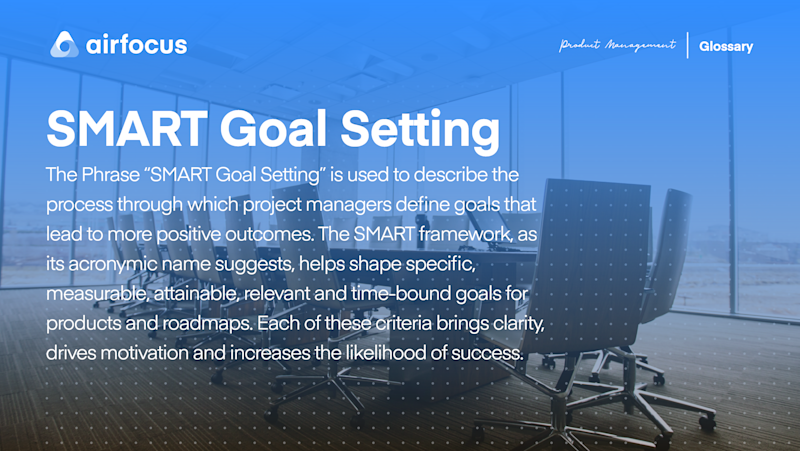SMART Goal Setting
What is SMART goal setting?
Definition of SMART goal setting
The phrase “SMART goal setting” is used to describe the process through which project managers define goals that lead to more positive outcomes. The SMART framework, as its acronymic name suggests, help shape specific, measurable, attainable, relevant, and time-bound goals for products and roadmaps. Each of these criteria brings clarity, drives motivation, and increases the likelihood of success.
Many product managers struggle to achieve goals that are too broad or try to hit too many targets without seeing tangible results. By switching to a SMART goal setting approach, they can cut through the clutter and narrow their teams’ focus on clear, reachable objectives.
And while it’s especially useful to PMs, the SMART goal-setting tool is easy to use by anyone — and can be applied to any aspect of business or life.
What does a SMART goal need to include?
When you define a SMART goal, you need to make sure you tick off all the criteria included in the acronym. These are the core aspects that will ultimately make or break the objectives of your project roadmap, product strategy, and development efforts in general.
For starters, a SMART goal should include specific details. To make sure you don’t miss anything, define your goal by spelling out the answers to the five Ws questions: what, why, who, where, and which. For example, imagine that you are currently building a finance platform. A specific goal would be: “I want to coordinate a team of two UX designers and four developers to build a finance platform that will become the leading solution for small businesses by the third quarter of next year”.
Next, your SMART goal should include measurable criteria to help you assess progress. Setting clear deadlines is just one of the things to consider. Depending on the nature of your product, you can track metrics that allow you to identify exactly when your goal is reached — such as the number of features or percentage of tests passed.
To set yourself up for success, your SMART goal needs to be attainable. That means you should stay away from goals that are too daring. However, don’t limit yourself by setting the bar too low either. Ideally, an attainable goal should challenge your abilities but remain realistic.
It’s also vital for a SMART goal to be relevant. A good project manager will look at the overall strategy of a company and attune their project goals with other business objectives.
Last, but definitely not least, a SMART goal should be time-bound. Inside the end-deadline frame, establish smaller milestones for better control.
What are the benefits of using SMART goal setting?
Without clear and realistic goals, a project can crumble under its own weight. By following the SMART goal setting approach, project managers can make the most out of their time and resources. This is possible because the framework provides clarity, focus, and motivation, driving teams to achieve challenging goals with more ease.
Overall, the benefits of using the SMART goal setting approach are closely connected to the higher rate of positive outcomes in project management. After all, only by knowing where you’re headed can you reach your destination.

General FAQ

Glossary categories
Prioritize with confidence

Experience the new way of doing product management








